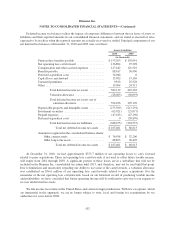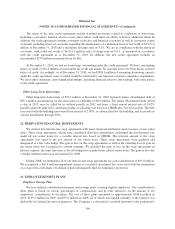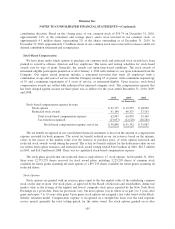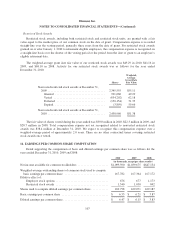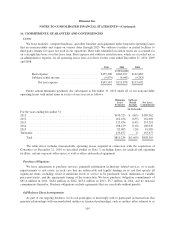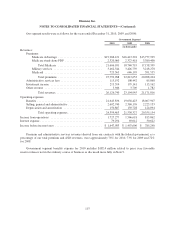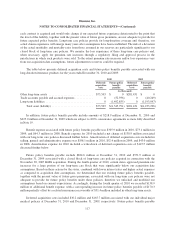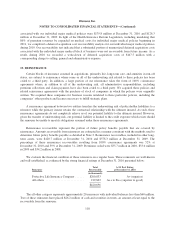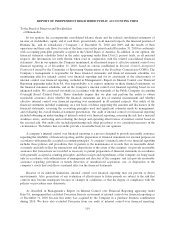Humana 2010 Annual Report Download - page 121
Download and view the complete annual report
Please find page 121 of the 2010 Humana annual report below. You can navigate through the pages in the report by either clicking on the pages listed below, or by using the keyword search tool below to find specific information within the annual report.Humana Inc.
NOTES TO CONSOLIDATED FINANCIAL STATEMENTS—(Continued)
On December 21, 2010, CMS posted a description of the agency’s proposed RADV sampling and payment
adjustment calculation methodology to its website, and invited public comment, noting that CMS may revise its
sampling and payment error calculation methodology based upon the comments received. We believe the audit
and payment adjustment methodology proposed by CMS is fundamentally flawed and actuarially unsound. In
essence, in making the comparison referred to above, CMS relies on two interdependent sets of data to set
payment rates for Medicare Advantage (MA) plans: (1) fee for service (FFS) data from the government’s original
Medicare program; and (2) MA data. The proposed methodology would review medical records for only one set
of data (MA data), while not performing the same exercise on the other set (FFS data). However, because these
two sets of data are inextricably linked, we believe CMS must audit and validate both of them before
extrapolating any potential RADV audit results, in order to ensure that any resulting payment adjustment is
accurate. We believe that the Social Security Act, under which the payment model was established, requires the
consistent use of these data sets in determining risk-adjusted payments to MA plans. Furthermore, our payment
received from CMS, as well as benefits offered and premiums charged to members, is based on bids that did not,
by CMS design, include any assumption of retroactive audit payment adjustments. We believe that applying a
retroactive audit adjustment after CMS acceptance of bids would improperly alter this process of establishing
member benefits and premiums.
CMS has received public comments, including our comments and comments from other industry
participants and the American Academy of Actuaries, which expressed concerns about the failure to
appropriately compare the two sets of data. On February 3, 2011, CMS issued a statement that it was closely
evaluating the comments it has received on this matter and anticipates making changes to the proposed
methodology based on input it has received, although we are unable to predict the extent of changes that they
may make.
We believe that the proposed methodology is actuarially unsound and in violation of the Social Security
Act. We intend to defend that position vigorously. However, if CMS moves forward with implementation of the
proposed methodology without changes to adequately address the data inconsistency issues described above, it
would have a material adverse effect on our revenues derived from the Medicare Advantage program and,
therefore, our results of operations, financial position, and cash flows.
Our Medicaid business, which accounted for approximately 2% of our total premiums and ASO fees for the
year ended December 31, 2010, consists of contracts in Puerto Rico and Florida, with the vast majority in Puerto
Rico. Effective October 1, 2010, the Puerto Rico Health Insurance Administration, or PRHIA, awarded us three
contracts for the East, Southeast, and Southwest regions for a one year term with two options to extend the
contracts for an additional term of up to one year, exercisable at the sole discretion of the PRHIA.
The loss of any of the contracts above or significant changes in these programs as a result of legislative
action, including reductions in premium payments to us, or increases in member benefits without corresponding
increases in premium payments to us may have a material adverse effect on our results of operations, financial
position, and cash flows.
Our military services business, which accounted for approximately 11% of our total premiums and ASO
fees for the year ended December 31, 2010, primarily consists of the TRICARE South Region contract. The
original 5-year South Region contract expired on March 31, 2009 and was extended through March 31, 2011. On
October 5, 2010, we were notified that the Department of Defense TRICARE Management Activity, or TMA,
intended to negotiate with us for an extension of our administration of the TRICARE South Region contract, and
on January 6, 2011, an Amendment of Solicitation/Modification of Contract to the TRICARE South Region
contract, in the form of an undefinitized contract action, became effective. The Amendment adds one additional
111



